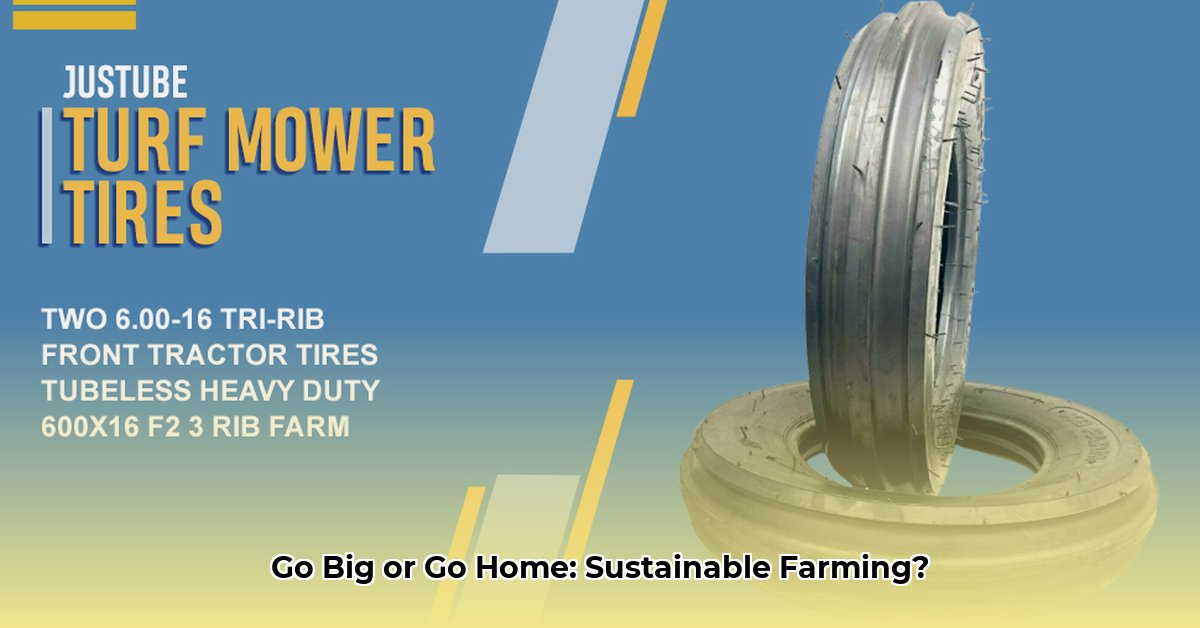
Choosing the right tires for your tractor significantly impacts your farm's sustainability. This guide focuses on 600x16 tractor tires, common for smaller to mid-sized tractors, detailing how to select, maintain, and dispose of them responsibly. We'll explore environmental impacts, cost analysis, and government incentives to help you make informed decisions. For more detailed information on 16-inch tractor tires, check out this helpful resource: Tire Size Guide.
Understanding 600x16 Tractor Tires: Beyond Rubber
600x16 tractor tires are crucial for efficient farming operations. Their performance affects fuel consumption, soil health, and crop yields. A poorly chosen tire can negatively impact all three. Careful selection is therefore essential. How can we improve our soil health and lower our carbon footprint through tire selection?
Tire Construction and Materials: Embracing Eco-Friendly Options
Traditional 600x16 tractor tires use natural rubber, a renewable resource. However, the manufacturing process is energy-intensive. Fortunately, bio-based alternatives are emerging, utilizing sustainably sourced plant oils or recycled rubber. While promising a lower environmental impact, their durability is still under research. This presents a trade-off between environmental benefits and performance longevity. What are the long-term durability implications of bio-based tires compared to traditional options, and how do these compare in terms of cost-effectiveness?
Tread Patterns and Soil Health: Minimizing Compaction
Tire tread design directly influences soil health. Aggressive treads offer superior traction, particularly in wet conditions, but increase soil disturbance and compaction. Finer treads minimize disruption, improving soil structure and water infiltration. The ideal tread depends on your soil type and farming practices. Sandy soils might benefit from aggressive treads, while clay soils require finer treads to reduce compaction. How does tread design affect soil compaction, and what are the yield implications for various soil types?
Tire Pressure: Optimizing Fuel Efficiency and Soil Health
Maintaining proper tire inflation is crucial. Underinflation increases rolling resistance, raising fuel consumption and soil compaction. Overinflation reduces traction and shortens tire lifespan. Regular pressure checks using a reliable gauge are essential. The manufacturer's recommended pressure should be followed, and temperature adjustments considered. How much fuel can be saved per year through the proper inflation of 600x16 tractor tires, and what is the associated reduction in soil compaction?
Maximizing Tire Lifespan: Practical Maintenance Strategies
Proper tire care extends lifespan and return on investment. Regular visual inspections for damage are vital. Rotating tires ensures even wear, and avoiding overloading prevents premature failure. Tire pressure monitoring systems (TPMS) provide real-time pressure alerts, preventing underinflation. What simple maintenance steps can significantly extend the lifespan of 600x16 tractor tires and reduce overall costs?
Recycling and Disposal: Responsible End-of-Life Management
Responsible disposal of worn tires is critical to prevent environmental pollution. Many regions offer tire recycling programs that reclaim rubber for other uses, diverting waste from landfills. Researching and utilizing local programs is environmentally conscientious. What are the local regulations and options for recycling or responsible disposal of 600x16 tractor tires in my area?
Choosing Sustainable 600x16 Tires: A Comprehensive Cost-Benefit Analysis
Sustainable tires often command a higher upfront cost. However, their longer lifespan and potential fuel savings often offset this. A total lifecycle cost analysis—including purchase price, fuel costs, and disposal fees— is essential for a comprehensive evaluation. "In many cases, the long-term savings can outweigh the initial expense," says Dr. Emily Carter, Agricultural Engineer at the University of California, Davis. What is the typical return on investment (ROI) for sustainable 600x16 tractor tires compared to conventional options, and how can a lifecycle cost analysis help farmers make informed decisions?
Government Incentives and Regulations: Supporting Sustainability
Government agencies often offer incentives for adopting sustainable agricultural practices. Tax breaks or subsidies for purchasing eco-friendly tires might be available at the local, state, or federal levels. Staying informed about regulations related to agricultural tire use and disposal is crucial. What are the current government incentives and regulations promoting sustainable agriculture practices related to tire adoption and disposal in my region?
Comparing Tire Options: A Summary
The table below provides a general overview of different tire options. Individual experiences may vary.
| Tire Type | Initial Cost | Lifespan | Fuel Efficiency | Environmental Impact |
|---|---|---|---|---|
| Traditional Rubber | Lower | Moderate | Moderate | Higher |
| Bio-Based Rubber | Higher | Potentially Higher | Higher | Lower |
| Reclaimed Rubber Blend | Moderate | Moderate | Moderate | Moderate |
This guide provides a framework for choosing sustainable 600x16 tractor tires. Your specific needs and farming context will determine the best option. Consult agricultural experts for personalized guidance. Remember that information evolves with ongoing research in sustainable agriculture.